Review and photos by Bokisaurus
Tyrannosaurus rex is without a doubt the most famous dinosaur of all time. He is also one of the biggest, and for a while the largest predatory theropod found to-date.
He has held that distinction for decades and still do so to some extent today. Throughout the succeeding decades, there has been plenty of other big carnivorous theropods that tried to dethrone the king. Some came close, but ultimately failed to dethrone the beloved king.
Today, we will take a look at the most recent dinosaur who is trying to edge out the mighty king.
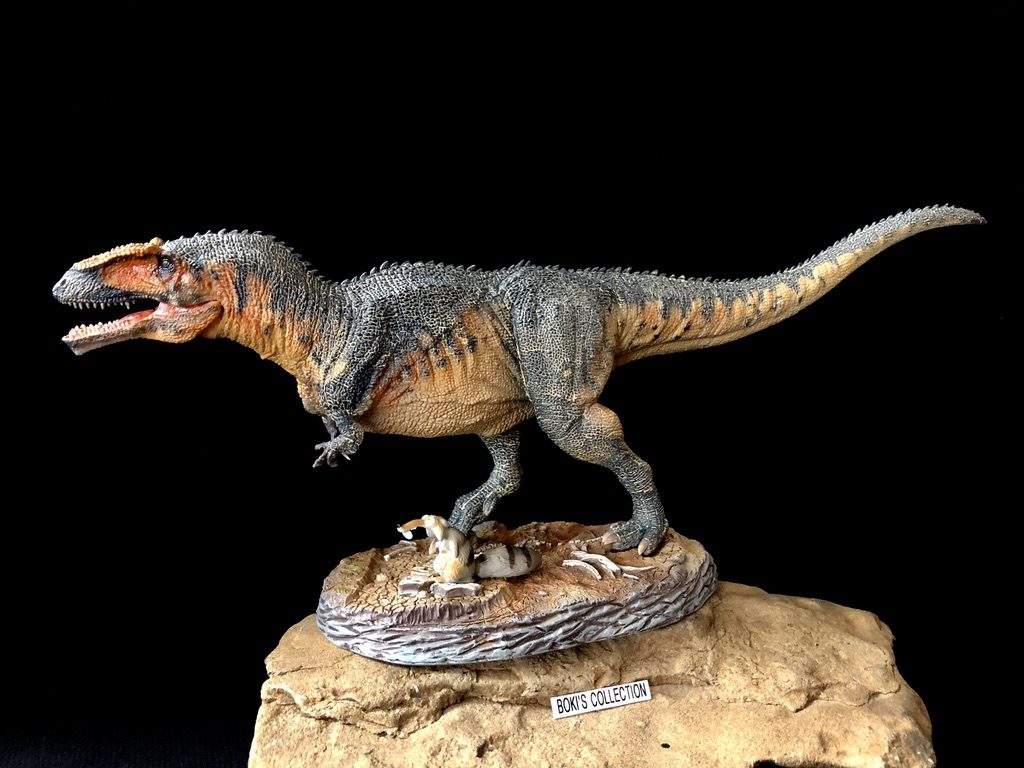
Meet Giganotosaurus carolinii the “giant southern lizard”. Any discovery that could potentially dethrone the mighty king is surely going to command attention.
As expected the discovery of Giganotosaurus in 1993 caused a lot of excitement as well as opened up new questions. At that time, the headlines billed it as the largest predatory dinosaur ever discovered.
It was discovered in what is now Argentina in South America. It lived during the late Cretaceous period, a time when some of the biggest dinosaurs roamed the planet.
There must be something going on down south that produced some truly gigantic dinosaurs during the late Cretaceous.
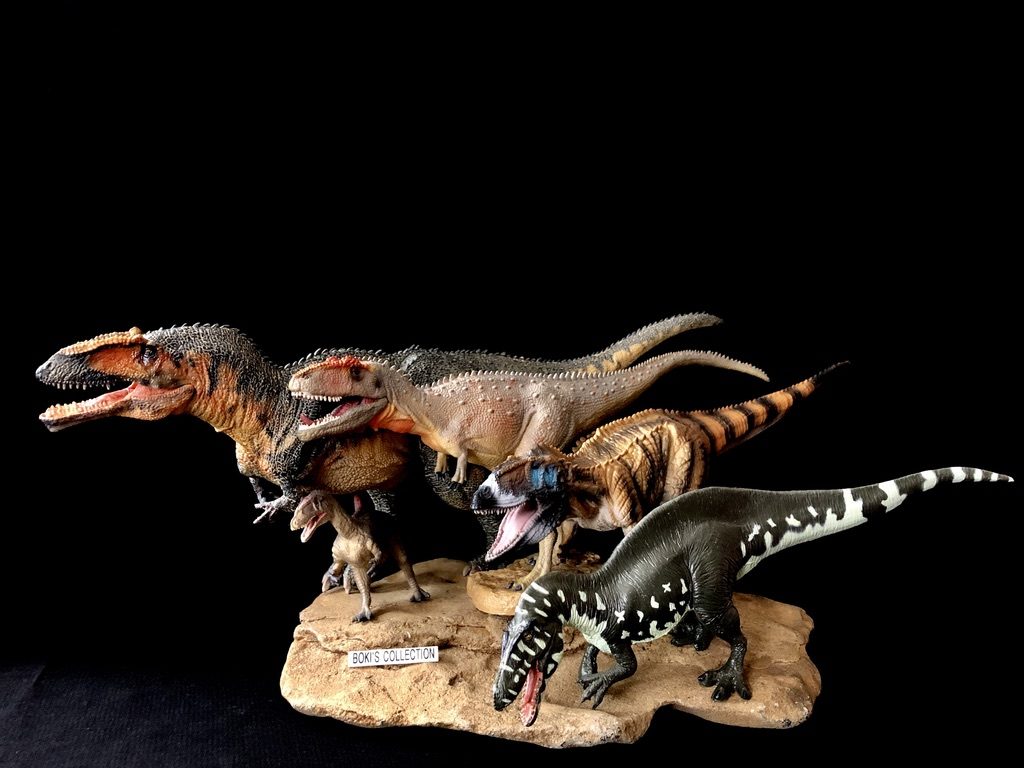
Giganotosaurus is part of the family Carcharodontosauridae, a family of truly large and majestic theropods which includes other giants, such as the closely related Mapusaurus and Carcharodontosaurus. They had worldwide distribution and were, without a doubt, the apex predators of their time.
Despite their large size, complete fossils of these impressive beast are rare, so the discovery of the holotype Giganotosaurus skeleton at 70% complete is truly amazing. This makes Giganotosaurus one of the most complete member of the group.

As far back as I can remember, Giganotosaurus is one of the most requested and hoped for in the forum. But despite the popularity, it was only within the last 3 years that toy companies really started to shift their attention to this species, to the delight of fans.
Veteran toy makers Safari and Shleich, as well as newcomer Eofauna released figures of this beast within the last 3 years.
The subject of today’s review is the latest, and in my opinion, the best version out there.
So let’s take a closer look at PNSO’s take on the giant southern lizard.
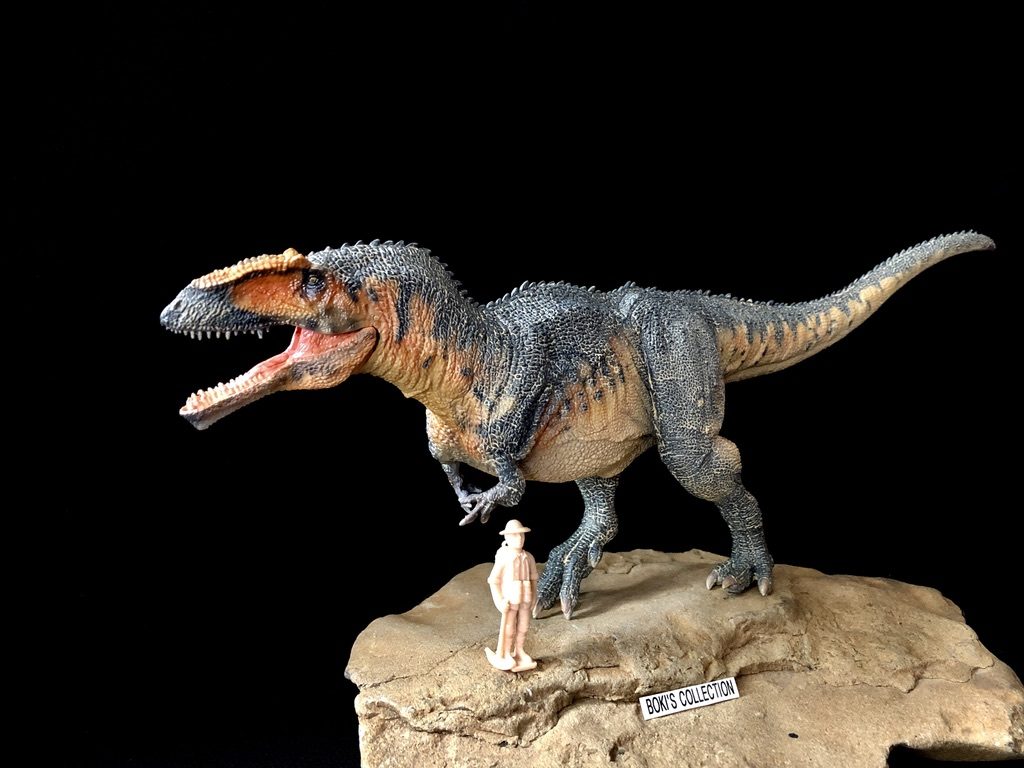
We first got a glimpse of this figure way back in 2017 when prototype of planned and unreleased figures were posted, including this figure, back then it had a different color. The chaos that derailed PNSO for two years kept fans guessing if we will ever see this prototype be a reality. Well, here we are today, two years later, and indeed, most of those prototypes have now mostly been released.
Part of the larger and more expensive Dinosaur Museum Line, this Giganotosaurus figure is big and truly majestic looking. Officially listed as 1:35 scale like all the other figures in the series.
The figure measure almost 16” inches long (with the curvature of the tail and neck ) and stands 6” inches tall (if posed in a more horizontal orientation). It’s a good size model that outmans the other two recent Giganotosaurus figures from Safari and Eofauna. If compared with these two, this PNSO figure could easily be considered the larger, fully grown individual.
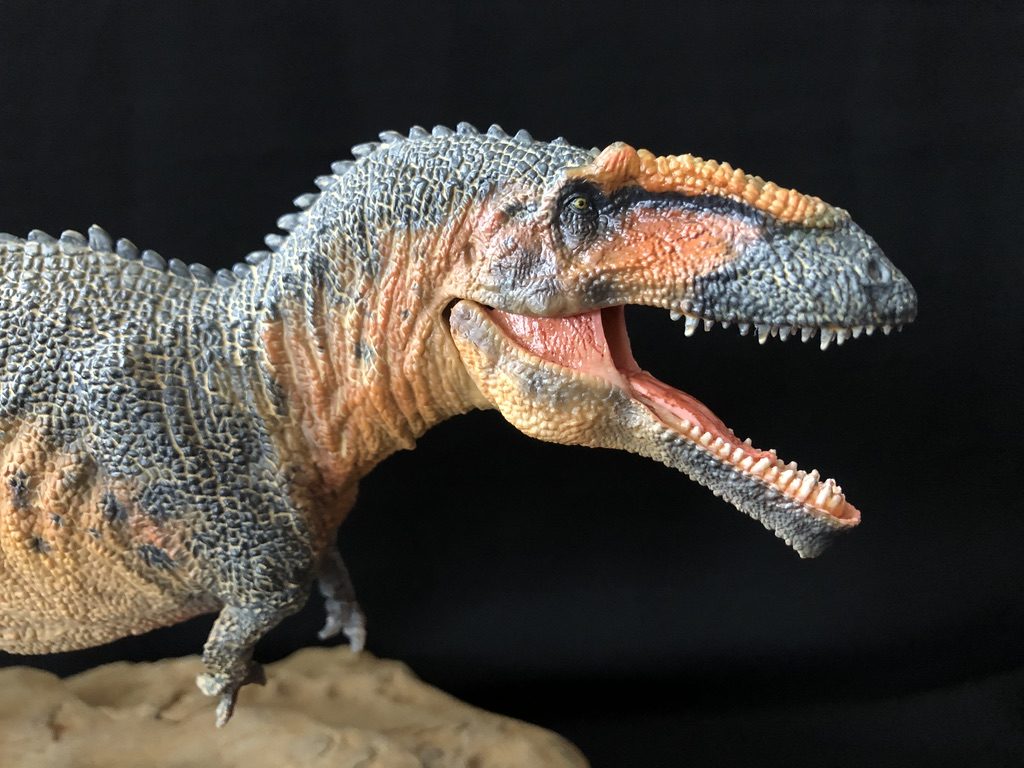
The head is big and unmistakably that of Giganotosaurus.
Perhaps the most unique characteristic of this animal is that distinctive notch on the tip of the lower jaw. In this model, it is very pronounced. The lower jaw is thin and not as muscular as the other two so it looks longer and more square. There is also a deep depression on the underside of the lower jaw.
The upper part of the head also suffers from not having enough muscle and have that pinched look which is especially noticeable just below the ridge and crest above the eye.This really gives the figure a narrow and longer looking head when viewed head-on.
Speaking of the ridge and crest, they are beautifully done with lots of small little bumps.
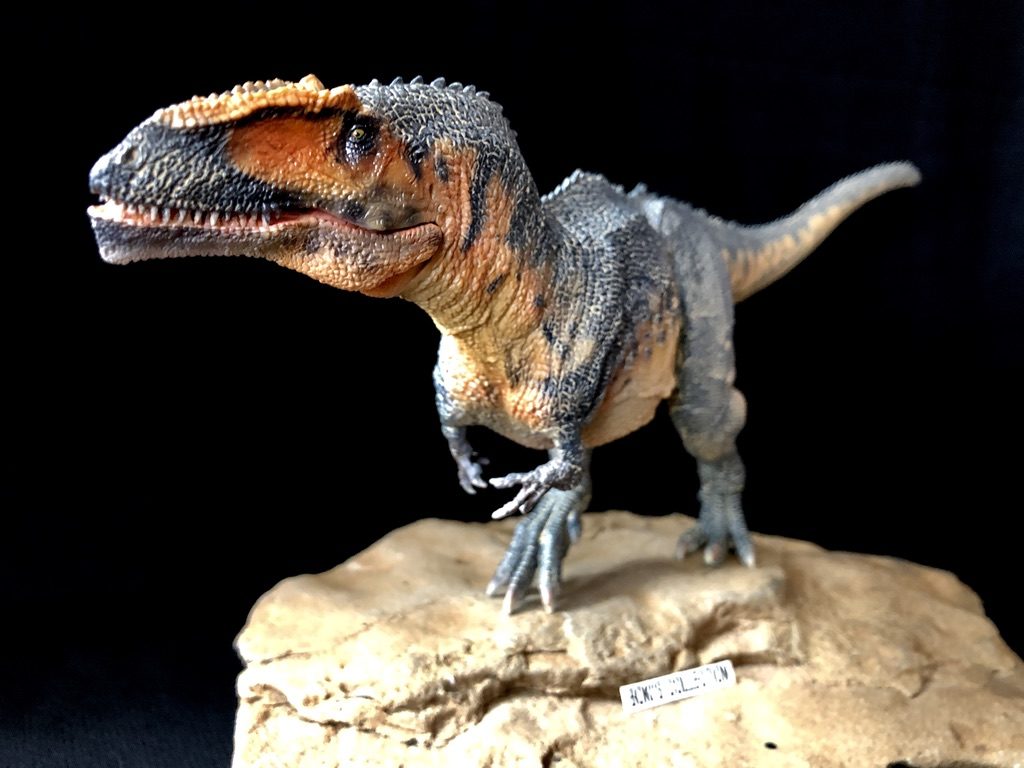
The jaws are articulated and fits smoothly and nicely executed to the point that the joints are cleverly arranged so they are not too visible and easily incorporated into the folds of skins.
The teeth are sharp and individually sculpted. It really shows how much attention to small details PNSO gives to each models. The paint job is also very clean with no signs of bleeding despite the small surface of each individual teeth.
The yellow eyes are small and set way back, but despite the size, it is painted clearly and shows small details such as the pupils.
As expected, there are so much details packed into the head, ranging from very delicate and small scales to bumps and skin folds. This really gives the figure so much depth and when you feel it, you can really appreciate the varied textures.
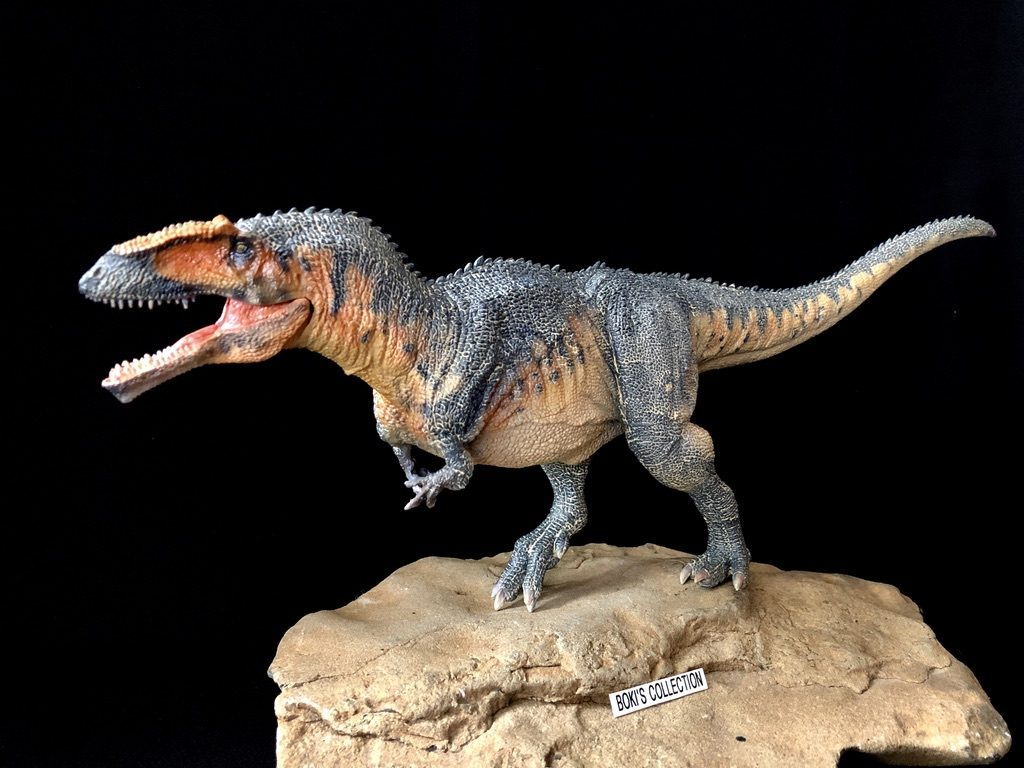
Moving down the body, the neck and the back of the head is robust and very muscular as it should be. That distinctive bump on the back of the head is very visible.
The dorsal spines that runs along the entire back and tail starts at the back of the skull just after the eye ridge. These spines vary in size depending on which part of the body it is located.
Often in dinosaurs figures, the scales are too big and uniform in size which I always found unappealing.
PNSO does a fantastic job of scaling down those individual scales so it fits the size of the figure. They also make these scales different in size and shape which adds to the realism. On top of that, there are skins folds and lines that criss-cross the scales adding even more depth and texture.

The body is huge and very muscular, you can almost feel the weigh and the power of this animal. The various skin folds really capture and movement of each body parts and helps give the figure a really dynamic feel.
The arms are well proportioned and very detailed. The nails are especially sharp. Now, there is no evidence that the family Carcharodontosauridae ever had feathers.
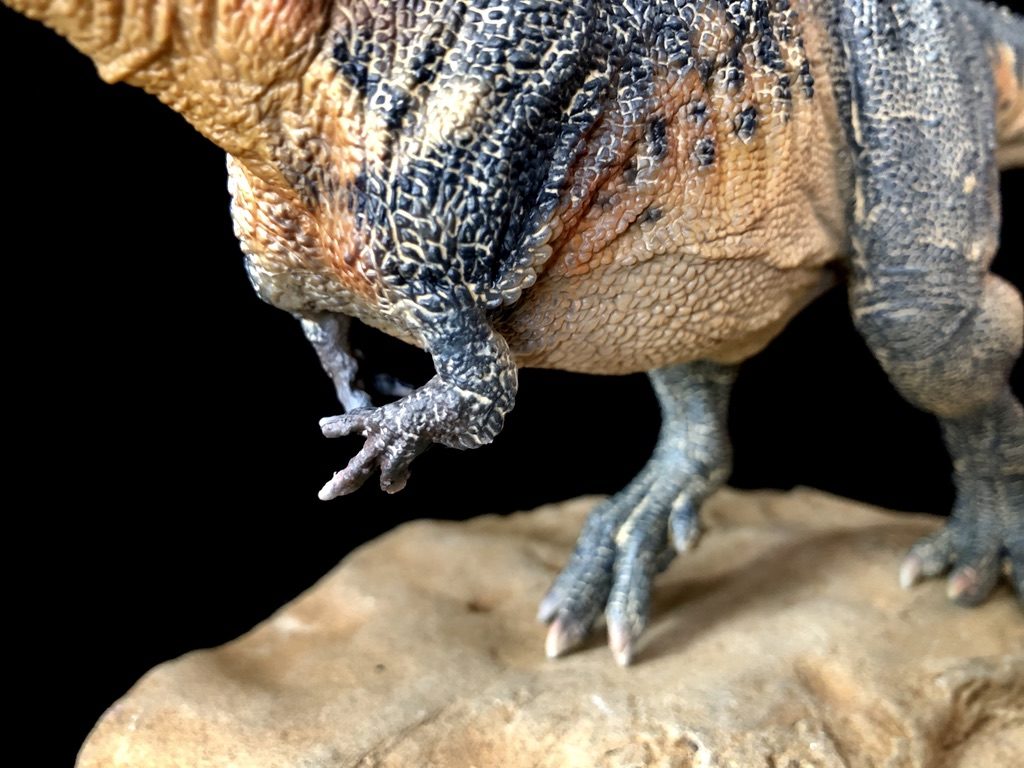
As I looked closely at the arm of this figure, I noticed some structures that looks like feathers!
They are located just on the back of the arms and are very faint and not too obvious so its very easy to miss. Either way, it’s a nice little surprise.
I also love how each hands are posed differently instead of the typical way each hands are mirrored in the same orientation.

The legs are full of bulging muscle that really give you an idea of how powerful this animal is.
Giganotosaurus is built in a way that allowed it, despite its huge size, to still run pretty well and may have been one of the fastest of the really large theropods, with some estimating it can reach speed of up to 31 mph, now that is fast for something this large!
PNSO is able to capture this, more than any other figures in my opinion. Often we see large predatory theropods figures with tail base that are too skinny. Not this one.
The base of the tail, the area that powers it, is huge, deep, and really muscular, perfect for an animal of this size that relies partly on speed to take down prey. The tail is long to counter balance the heavy front. It is held in a horizontal position with the last quarter slightly raised and curved upwards giving it a sense of motion.
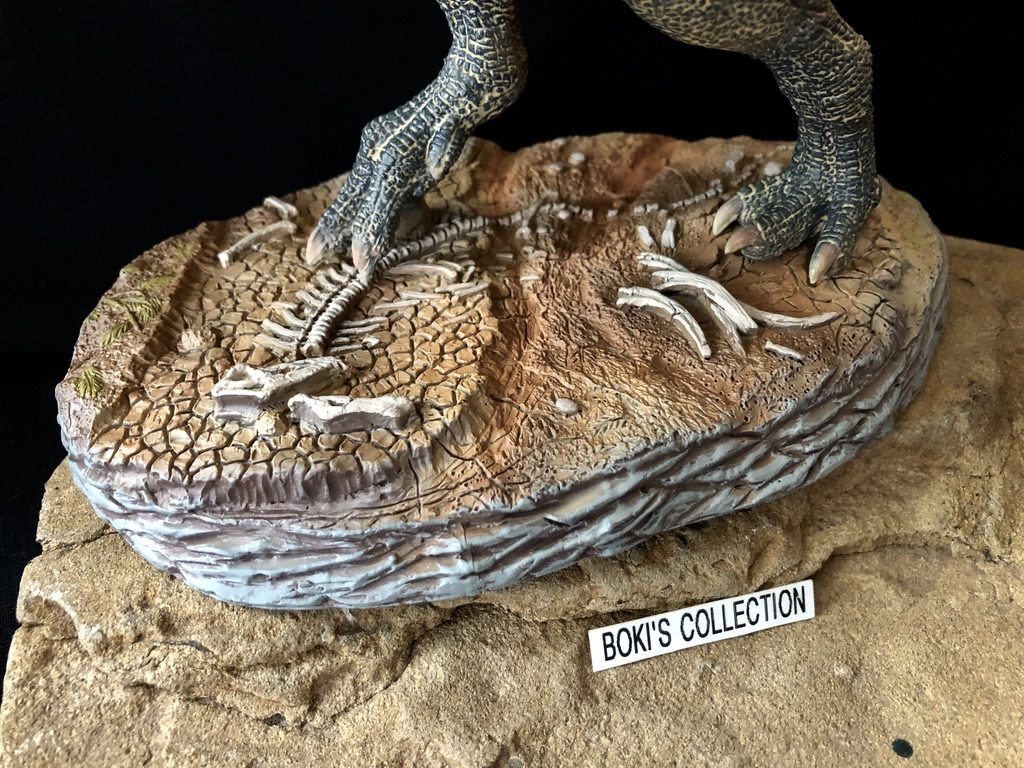
The feet are nicely proportioned as well and you can even see details on the pads. Gone are the large bird-like scales we often see done on the lower legs of theropods, instead in this figure we see varied scale sizes with the largest on top of the toes.
The nails is painted realistically in a grayish tone with slight pink, something we see in modern animals. This is a nice break from just the black or gray we often see.
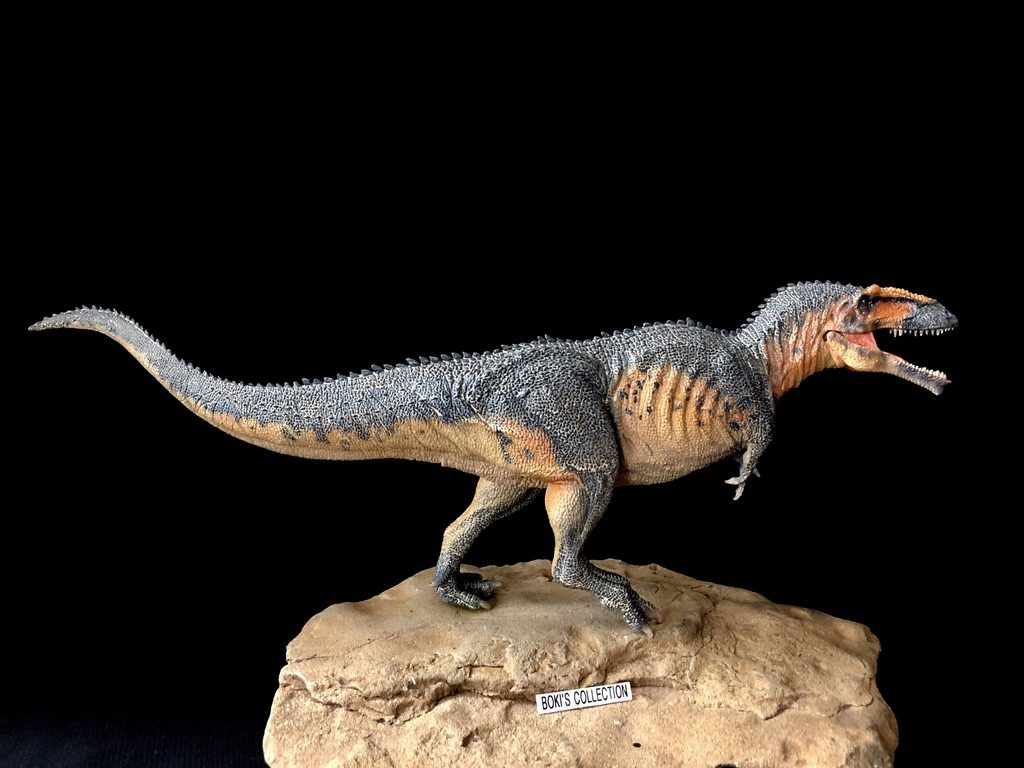
The color given this model is really one of my favorite seen on a large predatory theropod. The overall body color is dark brown (almost black) on the top part and light brown on the lower half.
The darker color slowly transitions to the lighter brown color by turning into bands and spots from the neck all the way down the tail.
On the middle chest area we see a splash of rusty orange and yellow, we see these colors repeated again on the base of the tail as it runs along the center line dividing the two dominant colors.
On the head, we really see the brightest tone of these colors. The rust orange is bright and really light up the upper half of the head and lower jaw/neck area. The ridge and eye crest also have the bright orange colors.
This combination is really pleasing to look at and looks very natural. A light brown wash is applied throughout the figure that really enhance the details and gives the figure a more matted look, or maybe more like what the animal would have looked like after a dust wallow.

Like all models from the Dinosaur Museum line, it too comes packaged in a nice elegant white box and comes with a booklet.
The figure also has a base to display it on. The base is a slice of a dried up river bed with cracked mud and rocks.
There is an unidentified skeleton as well laying on the ground that the models tower over when on the base.
The left foot has a hole that attaches to the metal rod on the base for added stability, while the right foot is raised slightly and rest on top of a large rock.
I read that some people have issues with the model falling over or leaning. I, fortunately, have not had that experience with mine. Its been on the shelf for months now and I never had any issues with it falling or leaning over. As the figures are made of hard PVC plastic, perhaps temperature could possibly soften the material causing it to lean over.
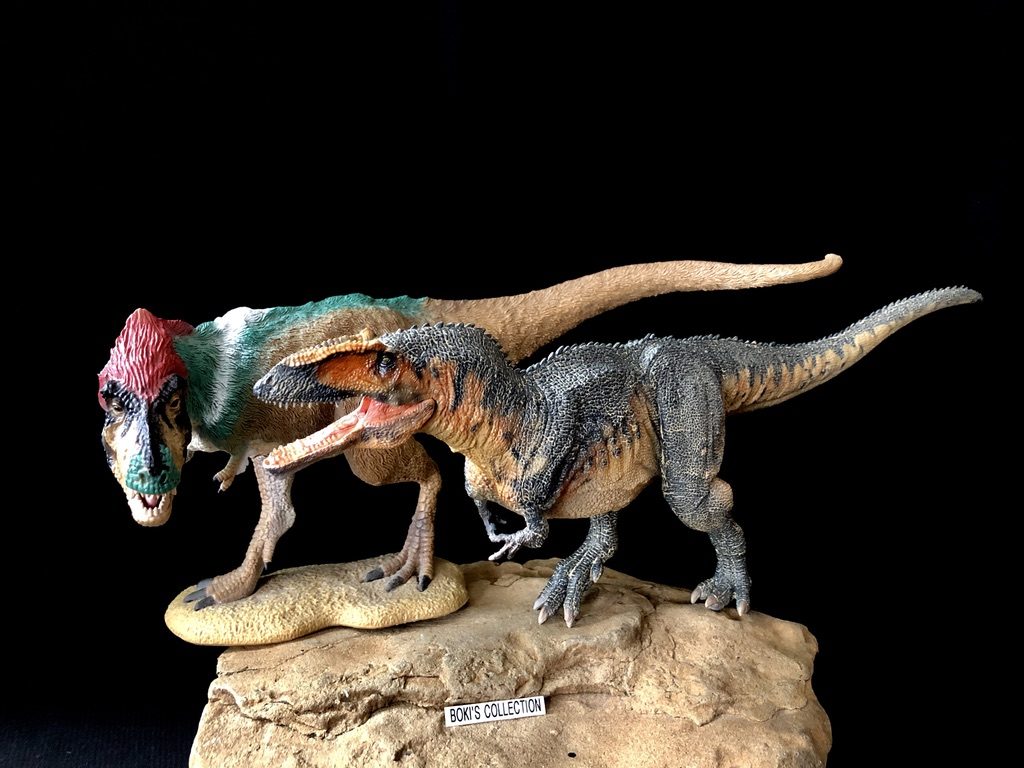
So, was Giganotosaurus bigger than Tyrannosaurus? The answer is not as clear as one would hope. It is definitely one of the largest predatory theropod ever found. But it is believed that when it came to body mass, Mr. Tyrannosaurus rex still outweigh it.
It is more lightly built than Tyrannosaurus, but longer with estimates length ranging between 39-43 ft. compared to tyrannosaurus’s 40 ft., better suited to a faster lifestyle of chasing down prey which included some large titanosaurs that roamed the region. As impressive size as their size are, in the end, the enigmatic Spinosaurus still wins in the size department.
With only fragmentary Giganotosaurus fossils currently exist,until more complete materials are found, the debate will continue.
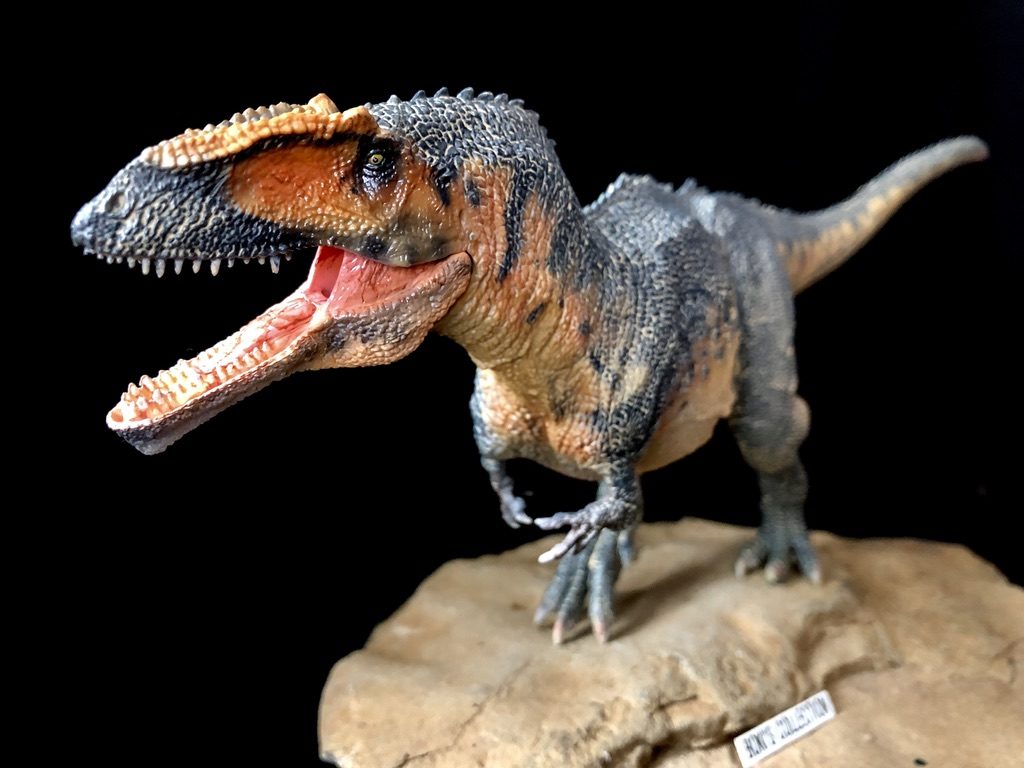
In closing, I really like this PNSO version of Giganotosaurus, so much so that it is my favorite of the large predatory theropods I currently own. The colors are beautiful and natural looking.
The exquisite attention to details is unmatched and truly takes this figure and others in the series to a whole new level, somewhere between high-end resin with the price tag of a toy figures.
The level of realism is astonishing and well researched and executed. It definitely makes others, well, look like toys when next to this model.
If large predatory dinosaurs are your thing, or just wanting a centerpiece for your collection, then this is definitely something you should add. Its beauty and majestic appearance will surely impress you and would be an eye-catching conversation piece.

Well, that concludes another PNSO review!
Thanks for ready and hopefully you enjoyed the review. Until we meet again, take care. Cheers!
.
Support the Dinosaur Toy Blog by making dino-purchases through these links to Ebay and Amazon. Disclaimer: links to Ebay.com and Amazon.com on the The Dinosaur Toy Blog are often affiliate links, when you make purchases through these links we may make a commission

It is for me one of the best giganotosaurus made to date, we must also highlight the details of its beautiful base with beautifully sculpted bones and stones. As the author Bokisaurus says the details are fabulous and it is of an identical quality to the resin figures with the difference that it is made of a more affordable and non-breakable material. It is a figure completely made for collectors. My congratulations PNSO and I hope that next year we will continue to delight with equal or better figures like this one.
As a final comment I can say that my giganotosaurus without the base has no sustainability problem which for me is a fortune and an advantage. This figure is recommended at one hundred percent.
Actually, Scotty, the one T. rex that was described in Canada this year, is 43 ft long and 9.8 tons, so it edges out Gig in the size department.
funnily enough, I just had this guy arrive about 15 minutes before I saw this review. It’s a really lovely figure, regardless of a little shrink wrapping. I’m really developing a taste for PNSO figures. Great review.
Muy buena crítica, estaba esperando una revisión de este terópodo sudamericano…la figura es muy bella, el color, la pose, la corpulencia etc..lo único que le crítico es la forma del cráneo alargado me recuerda más a su pariente Mapusaurus de planeta dinosaurio, que al cráneo de Giganotosaurus. Por lo demás es una de las mejores figuras, muchas gracias
Terrific review of is probably the best Giganotosaurus yet.
According to the most recent mass estimates, including those in Dinosaur Facts and Figures: The Theropods and Other Dinosauriformes (which is a must-have for any dinosaur fan), Giganotosaurus and Spinosaurus were 8.5 tons and 7.5 tons respectively. As for T. rex, the Sue and Scotty specimens are estimated to have been 9 tons and 9.8 tons respectively. So while T. rex comes in third place length-wise, it takes first place in terms of mass.
Reminds me of the colour scheme of Giganotosaurus in Dinotopia and the contemporary National Geographic articles also illustrated by James Gurney.
It seems to have the longish skull recently dismissed by various writers (Scott Hartman, Gregory Paul)?